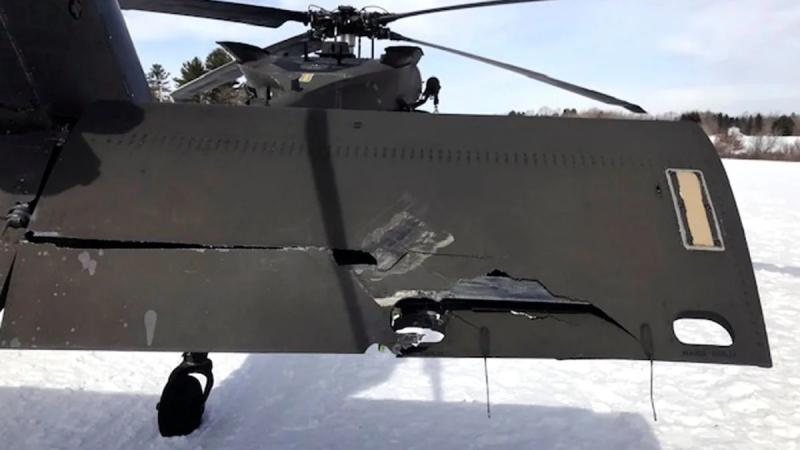Man who crashed snowmobile into Black Hawk sues government for $9.5M
By: Yahoo News



Jeff Smith was whizzing along on a snowmobile one evening a few years back when something dark appeared in front of him. He hit his brakes but he couldn't avoid clipping the rear tail of a Black Hawk helicopter parked on the trail.
The March 2019 crash almost cost Smith his life and is now the subject of a federal lawsuit by the Massachusetts lawyer. He is demanding $9.5 million in damages from the government, money he says is needed to cover his medical expenses and lost wages, as well as hold the military responsible for the crash.
"The last five years, there's been surgery, recovery, surgery, recovery," said Smith, who lost the use of his left arm, suffered respiratory issues since the crash, and hasn't been able to work full time. "Honestly, right now, it feels like I'm in a worst place than when I first had the surgeries in 2019."
A U.S. District Court judge in Springfield is expected to rule on the lawsuit later this year.
Smith's lawyers in the yearslong court case argue that the crew of the Black Hawk helicopter that flew down from New York's Fort Drum for night training was negligent for parking a camouflaged 64-foot (19.5-meter) aircraft on a rarely used airfield also used by snowmobilers. Smith also sued the owner of Albert Farms airfield in Worthington, Massachusetts — accusing them of both giving permission to snowmobilers to use the trail and the Blackhawk crew to land in the same area. He settled with the farm owner for an undisclosed sum.
Smith argues that the crew didn't do enough to protect him, including failing to warn snowmobilers of the helicopter's presence on the trail, leaving the 14,500-pound (6,577-kilogram) aircraft unattended for a brief time and failing to illuminate it. The helicopter landed on an air strip approved by the Federal Aviation Administration and the crew members testified that trainings are often conducted in similar locations. But Smith, who said he had snowmobiled on the trail more than 100 times, said the last time an aircraft used it was decades ago when he was a child — and never a military aircraft.
"Our argument from the beginning has been that it's incompatible to have a helicopter land on an active snowmobile trail," Smith's attorney, Douglas Desjardins, said, adding that the lawsuit was filed after the government failed to respond to their damages claim.
"The Army internal investigation showed pretty clearly that the crew knew that they were landing right before or right after on an active snowmobile trail," he said. "What bad could happen there? You know, helicopter on a snowmobile trail where folks go fast."
A damaged snowmobile which crashed with a Black Hawk helicopter, March 13, 2019, in Worthington, Mass. (Army photo provided by attorney Douglas Desjardins/AP)
The government has attempted to dismiss the case several times, arguing that it can't be sued under the Federal Tort Claims Act since this involves a policy decision. A spokesperson for the U.S. Attorney's office had no comment.
They also argued that the court lacked jurisdiction and that the crew wasn't told that they were landing on a snowmobile trail. They also pushed back on claims they could have prevented the accident, saying there was nothing in their policies that required illuminating the helicopter. They also attempted to cast blame on Smith for the accident, claiming he was driving his sled more than 65 mph (105 kph) at the time the crash and that he had taken both prescription drugs and drank two beers before his ride.
In its investigation, the Army concluded the crew wasn't aware they were landing on a snowmobile trail in the crash. It also questioned whether glow stick-like devices known as chem lights used to light up the craft would have made a difference.
"I found no negligence by the crew and believe they complied with all applicable regulations and laws," according to the report. "Furthermore, given the particular circumstances of this incident, I am not convinced that using such chem lights or similar devices would have prevented the collision."
The night of the accident, Smith said he was over at his mom's helping fix a computer. He had a beer with dinner and then another with his dad, before setting off to meet his brother, Richard Smith, on the trail. Smith drove in the dark alongside farm fields and forests before going over a ridge. His headlights reflected off "something," he said, but Smith only knew it was a helicopter after the crash.
The testimony from the crew and the people who had come out to see the helicopter painted a chaotic scene after the crash, in which Smith was thrown from his snowmobile and his sled went flying through the air.
"I found him face down in the snow," Benjamin Foster, one of the crew members, told the court. "We rolled him on his back and I might remember yelling or telling one of my crew chiefs to grab some trauma shears and space blankets from the aircraft. ... I remember him gasping for breath."
"As soon as I heard that somebody on a snowmobile hit the helicopter, I knew it was my brother," Richard Smith said. "My heart hit my stomach. I just knew it was him. I went down there and my father told me he was alive. I didn't sleep that night. I spent that night on my knees praying."
Smith was airlifted to a trauma center, with a dozen broken ribs, a punctured lung and severe internal bleeding. "It was a mess," Jeff Smith said.
The 48-year-old returned home after a month in the hospital. But he continues to struggle with simple tasks, including putting on socks or pulling up his pants. Worse, he no longer golfs or snowmobiles —- including rides with his brother, friends and his 20-year-old son, Anthony. He gets by on federal disability assistance and lives with his parents.
"We went away that winter before the accident a couple times and he had gotten to that age where we were really bonding," he said. "I feel like it got robbed from me."
For Richard Smith, it's meant the loss of his riding partner. "It has destroyed me," he said.
Jeff Smith is now pinning hopes on winning the lawsuit, which he said would help pay for a procedure at Massachusetts General Hospital that attaches an electronically-controlled brace that would improve movement in his left arm.
"It would change my life," he said. "I would certainly be able to function and it would easier to do the daily activities of daily life like brushing my teeth, taking out the trash and opening door with one hand."




How do you miss a 64-foot, 14,500-pound UH-60 Blackhawk Helicopter?
You don’t unless you are drunk and/or distracted.
He didn't that is the problem.
Snowmobile trails are usually on rolling ground with hills, curves, and, as noted, ridges. Driving at night you tend to get tunnel vision even at the slower speed of 65 mph. A Blackhawk helicopter isn't painted to be reflective but the exact opposite.
Remember this happened on an airfield. Fairly level ground.
It's on the snowmobile operator to
Went back through the article and sure enough it was on an airfield, but even if it wasn't, like you said, it was on the snowmobiler.
Well it was at night and the airframe is painted black.
Having said that, we have no idea of the quality or age of his headlamp.
Now, we also don't know what the "prescription meds" were or if it was just two beers.
In any case, going 65mph on a snow mobile is as dangerous a thing as you can do on a wooded trail even in broad daylight.
At night it's paramount to a death wish.
yea, but a hell of an adrenaline rush
I wonder how many hundreds of thousands his insurance company paid to repair the Blackhawk?
Only problem is the article clearly stated the helo landed on an airfield. Ostensively flat and good vis in all directions.
This is clearly the riders screw up. No doubt.
He was also operating a snowmobile on an active air field.
That's the thing, on a snowmobile 65 isn't even really that fast. We had a 1970's Evinrude Trailblazer with the 437 30 HP and it would top out back then over 80 mph and our 650 Skimmer would peg the speedometer over 120 and since then with all the advancements in suspension and engines if you can't do easily 80 mph on the trails you'll be left behind.
It depends....
Agreed
Here is the airfield in question.
The west side of Huntington Road is forested, there's a large area at the north end of the airstrip bracketed by trees and trees behind the "airport building". The area south of the airstrip is cleared farmland for potatoes.
I guess that the actual site of the accident will determine field of vision.
I would guess that the helo would not land on the actual airstrip for obvious reasons
but the airstrip looks like its only good for small Cessnas and the like.
It is listed as "unattended" with three private single engine planes in "residence".
Actually, it was painted a dark green color called Helo Drab Green.
true story
Ok, flat black and glossy black are reserved for two specific units.
At night how much Helo Drab Green did the snow machine rider see before he landed face down in the snow?
I don't believe the picture of the damage indicates HDG as much as it appears to be blackish
but it certainly doesn't qualify as camo either, does it?
It's a very dark green and non-reflective, it can look black at night.
Not at all.
The flat black helicopters are exclusive to the 60th Special Operations Aviation Regiment. Their nickname, is the Night Stalkers, They do most of their flying at night.
For operations in the ME, our helicopters are usually a drab tan.
I think that FBI and CBP Black Hawks are a gloss Black.
Any person driving one vehicle hits a parked vehicle is responsible for what happens. I think I understand a bit about this guy:
"I found him face down in the snow," Benjamin Foster, one of the crew members, told the court. "We rolled him on his back and I might remember yelling or telling one of my crew chiefs to grab some trauma shears and space blankets from the aircraft
Imagine somebody talking like that? He has what some would call an overbearing personality. Right is right and he is wrong.
Without knowing all the material facts, the proximate cause of this accident appears to be the negligence of the snowmobile driver for failing to keep his snowmobile under control. If he had crashed into another snowmobile that was stopped ahead of him would the driver of the stopped snowmobile be at fault? I think not. With that said, it wouldn't be a surprise if the government ultimately entered into a settlement with him for some amount considering the significant nature and extent of his injuries and the possibility that a jury might accept some, or all, of his arguments regarding liability. For the responsible government authorities it's a matter of risk assessment and a "business decision" in light of their potential exposure.
If he would have crashed into a different type of aircraft he would be at fault. Remember, this happened on an active air field.
MA88 is listed as "unattended" with three private single engine planes in "residence".
There are no lights on the landing strip. The odds of hitting one of the three resident single engine planes at night
is nill they are in the building.
"Active" is maybe a legal description but it gives the wrong impression of this airstrip in the forest.